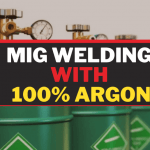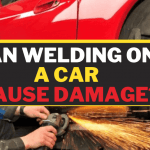Are you worried about how to strengthen the steel that you just welded to use it in your car or boilers? Don’t worry, in this article we are going to tell you about the processes through which you can strengthen your steel after welding. Welding can have its pros and cons and it can damage your welded steel to fracture during the application. And if you won’t be careful then you can reduce the life of the steel that you just welded.
Steel Welding
In order to strengthen the steel after welding, one should have a piece of prior knowledge of the type of steel that is to weld. Each steel responds differently to the different types of welding processes. Similarly, after welding, they respond differently to the heat treatment processes applied to strengthen and improve their properties.
For understanding and selecting the heat treatment process that is to be used for strengthening the steel after welding, one should prepare the steel according to the requirements that could help in performing a certain strengthening mechanism on the steel after welding.
For this understanding, the types of steel that are necessary discussed below:
1) Low Carbon Alloy Steel
In low carbon alloy steel, the carbon percentage is the lowest in all types of steel. They generally have a higher amount of alloying elements than carbon. It is usually used where the requirements are specific properties even if the material’s strength is compromised. These include stainless steel, which is corrosion resistant.
2) Medium Carbon Steel
These are steels that contain a medium amount of carbon. They are having a considerably better amount of carbon in them. If we talk about the medium carbon steel, they have some good strength with the combination of some other properties. These include mild steel, which is used in leaf spring with high strength and can absorb the cyclic load.
3) High Carbon Steel
These are having a higher percentage of carbon,brittle in nature. It can easily be break into two, for example, cast iron. Their strength is relatively high, but it is not having high toughness. They are used in making strong foundations and steel bars. These have high hardness and tensile strength but cannot absorb the cyclic load.
The post weld heat treatment processes that are performed to obtain the desired strength and properties depend upon selecting the steel types. You cannot do the same strengthening mechanism for low carbon steel that you’ve done for high carbon steel. Both have different temperatures and different heat treatment temperatures for annealing, normalizing, and aging.
More importantly, for post weld heat treatment processes for strengthening steel, it is necessary to control the welding process parameters. If you have selected optimum parameters that produce a good weld with a small heat affected zone, your strengthening mechanism temperature will greatly vary. So strengthening mechanism also greatly depends upon the welding process and its parameters.
To strengthen the steel after welding, you must do pre-weld heat treatments. It will ensure that your base metal is at the desired temperature and state to go into the welding process and result in a good quality weld. This good quality weld will result in a weldment that is suitable for strengthening by different heat treatment processes after weld.
Related Article: Can You MIG Weld Mild Steel With 100% Argon?
Strengthening Mechanism Of Steel After Weld
Once you know the material and all set with your welding, then the post weld heat treatment processes are done; these are to ensure that if any impurity or weld defects have occurred during welding, some post weld treatment processes can remove them.
It is also essential to consider the pre-heat treatment processes that can prepare the base metal to be suitable for a specific heat-treatment process. So the preparation of the base metal and weld groove is also required to be taken into account to ensure that welding is done precisely and the weldment has the right strength needed.
These processes are used to release any internal stresses generated during the welding. Also, they ensure to minimize the porosity that the weld develops.
These processes are generally done to increase the strength of the weldment. Some of these processes are discussed below,
Work Or Strain Hardened Metals
If the steel is strained before the welding is done, it will produce a quality weld without creating a higher heat affected zone. The heat affected zone is the area that is between the weldment and steel base metal. It is the part of steel base metal that undergoes changes because of its direct exposure to the welding torch.
Thus it is essential to do the strain hardening of the steel to have a reduced heat affected zone upon welding. This strain hardening causes the steel atoms to elongate, which does not leave any atom left for getting much excited when the torch or source of heat is applied for welding, thus reducing the steel’s heat affected zone.
Precipitation Hardened Metals
These are also some metals that go through a more complex process than the work-hardened does upon welding. These are having a 2nd phase particles in them, which acts as a dislocation boundary and does not allow dislocations to move freely inside the material’s atomic structure. They restrict the dislocation movement.
When 2nd phase particles are introduced into the metal, the new phase tends to be having its heat capacity, so once the steel is exposed to the welding torch/source of heat input, it tends to absorb more heat and reducing the heat affected zone. So this causes the reduction in the size of the heat affected zone giving it more strength.
Transformation hardened metals
These are the metals that tend to redesign their atomic structure once they are put through stress. The strain in them causes a considerable change in their microstructure. If you want to transform austenitic steel into martensite, you have to apply sufficient load at a higher strain rate. It will cause it to change into martensite from austenite.
These transformation hardened steels can go through welding, which tends to give a small heat affected zone and reduce heat affected zone means that the strength is increased considerably. Thus, this method can also be applied to increase the steels’ after weld strength, therefore considered one of the important methods of strengthening steel after welding.
More than this, post weld heat treatments are also very essential because they can help you to reduce the stresses that can lead to cracking. Furthermore, they can also lead to dissolving any martensitic and bainitic structures that form near heat affected zone. It causes the softening of material that leads to induce ductility in the material.
The bainitic and martensitic structure in the metal causes it to act a bit brittle. Thus, post weld heat treatment is required, such as annealing. In fact, there are more methods that one can use. The most important thing to consider is the critical heat, temperature, and cooling rate. If you can control these parameters in the post weld heat treatment processes, then you can get desired properties.
Mechanical Working
One can also strengthen the steel by mechanical working. If you work hardened the metal by passing it through the roller or giving it a compressive strength and then annealing it to restore the grain size, it will have much better strength and properties as compare to the weldment that was just welded.
The mechanical working elongates the steel grains and causes the dislocations to pile up onto one another or at the grain boundaries. These factors restrict the dislocation movement inside the grain, thus not allowing the plastic deformation to occur that causes the steel to be having high strength.
Annealing
After the welding, the weld pool grains and the base metal intersection are a bit fine since they were not given the ample time to solidify. So the welder can put a torch on the weldment so that the weld pool solidifies slowly, and it gives the weldment grain atoms some time to diffuse properly, and coarse grains are formed, which are having much higher strength.
Also, stress relieving annealing can be performed that releases the stresses that are formed during welding. It releases the stresses inside the weldment and causes an increase in strength. The stresses generated during welding cause the material to act brittle by restricting the atom movements. The stress relieving annealing causes the stresses to reduce so that steel regains its strength.
Final Verdict
Welding is a tricky and challenging job. When it comes to steel, you need to know how it will affect the steel structure and how much will be the deviation in the steel strength observed during welding. Most importantly, it would help if you controlled the weld parameters to retain the steel’s excellent strength.
If you want to get a quality weld, you should consider the above mentioned points and processes strongly and effectively as they will help you improve weld quality and your weld properties. Hopefully, you would have found this article helpful, which might have enhanced your knowledge.
Also Read: How To Connect PVC Pipe To Copper Pipe Without Welding?




